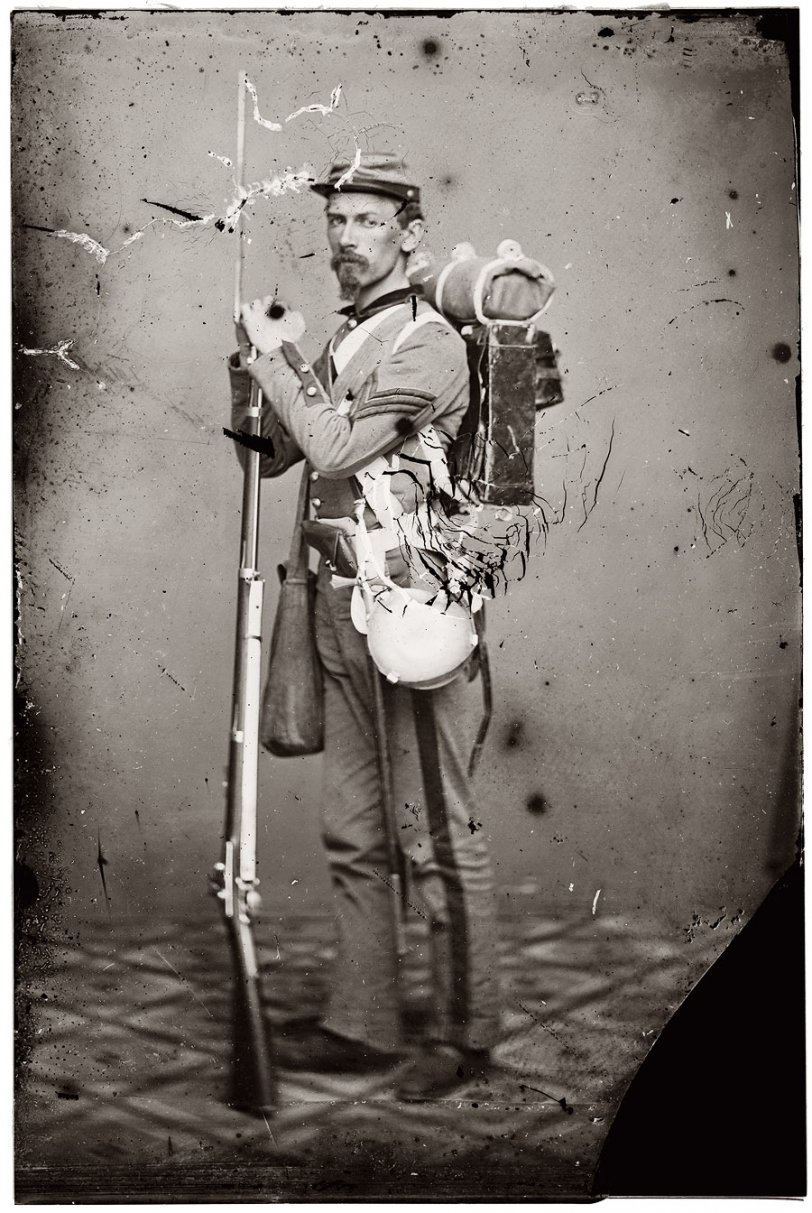


Framed or unframed, desk size to sofa size, printed by us in Arizona and Alabama since 2007. Explore now.
Shorpy is funded by you. Patreon contributors get an ad-free experience.
Learn more.

- Baldwin 62303
- Baldwin VO-1000
- Cold
- No expense spared
- Tough Guys
- Lost in Toyland
- And without gloves
- If I were a blindfolded time traveler
- Smoke Consumer Also Cooks
- Oh that stove!
- Possibly still there?
- What?!?
- $100 Reward
- Freeze Frame
- Texas Flyer wanted
- Just a Year Too Soon
- WWII -- Replacing men with women at the railroad crossing.
- Yes, Icing
- You kids drive me nuts!
- NOT An Easy Job
- I wonder
- Just add window boxes
- Icing Platform?
- Indiana Harbor Belt abides
- Freezing haze
- Corrections (for those who care)
- C&NW at Nelson
- Fallen Flags
- A dangerous job made worse
- Water Stop
Print Emporium
Joe Dore: 1860s

Sgt. Joseph Dore, 7th New York State Militia, circa 1860s. Civil War glass negative collection, Library of Congress. View full size.
Yes, he survived the war
The answer is YES, Joseph Dore survived the war. In 1860, Joseph Dore, a 27 year old bookkeeper born in New York, was living in the Lewis Opedyke household in New York City's 16th Ward. Lewis was a 47 year old carman born in New Jersey. In 1870, again in New York City's 16th Ward, Joseph Dorr, a 35 year old clerk born in New York, was living in the same building as 58 year old Lewis J. Updyke, who was born in New Jersey. Odds are extremely small that there was another pair of men matching those descriptions; in other words, it had to be the same Joseph. In 1870, Joseph was married to a lady named Mary A., and they had two daughters, Ida, age 10, and Blanche, age 2. They also had a Prussian-born servant living with them named Dora Milton, who was 19.
Joe Dore
Joseph Dore shows up in the 1860 census in New York City: he's a 27-year-old New-York-born bookkeeper, with a personal estate of $1000 (not bad at all). He doesn't seem to be married, and he's lodging with the family of Lewis Opedyke, a carman. I can't find him in the 1870 or 1880 censuses anywhere in the country, though (using the HeritageQuest census index, access provided by our local public library).
Joseph Dore
Did Sergeant Joseph Dore survive the war? The short answer is apparently yes.
As mentioned above, the 7th NYSM served twice in the field as a "30 Days" regiment. The first time between 19 April and 3 June 1861 and then again from 16 June to 21 July 1863. In both cases the 7th NYSM saw no meaningful action, but was instead used primarily for garrison and guard duty.
Dore reportedly deployed with his regiment both times as a Sergeant in Company C. There were officially five sergeants within a company, per standard tactical manuals of the day, but Dore's exact position is currently unknown to me.
The above photo was most likely made either in New York, before the 7th NYSM departed for Washington DC, or, instead, taken in a Washington DC portrait gallery. In either case, Dore's uniform and accoutrements indicate the photo was made very early in the war (i.e., April - June 1861).
Uniform
According to Don Troiani's "Soldiers In America: 1754-1865" the uniform of the 7th New York State Militia was "tailor-made of gray wool trimmed in black. Belts and straps were white leather." They probably retained this uniform for a considerable period.
Uniform
Many state militias had varying uniform types and colors before the war. The site I have referenced below showed that the photo was taken between 1860 and 1870. Wikipedia says "The 7th Regiment of the New York Militia was an infantry regiment in the Union Army during the American Civil War.
The 7th Militia was a pre-war militia unit that was activated for the Civil War. After organizing and brief training, the regiment left New York City for Washington, D.C., on special call of President Abraham Lincoln on April 19, 1861, arriving in Annapolis Junction, Maryland, and opening communications with Washington April 24–25." The regiment was mustered out finally mustered out July 21, 1863.
It is highly likely that upon activation this soldier and many others had their pictures taken as was fashionable at the time. Also his equipment looks brand new and he is carrying a hardpack knapsack which was a pre-war militia item and would have been replaced later by a double bag knapsack.
Joe Dore
Is it possible that it is blue, but that the primitive film process didn't render it as dark as we would expect? Much like "orthochromatic" B&W movie film prior to the mid 1920's.
[He's in the state militia, not the Union Army. And re "primitive film process," there was no film back then. - Dave]
It's interesting that the NY
It's interesting that the NY militia wore light-colored uniforms this late in the war. I assume they weren't gray. Can someone tell us what color they were?
























On Shorpy:
Today’s Top 5